The 1969 Datsun 510 wasn’t just another car; it was a revolution. This Japanese import, with its sleek design and surprisingly potent engine, disrupted the American automotive landscape, challenging the dominance of Detroit’s big three. It wasn’t just a car, it was a statement – a testament to Japanese engineering prowess and a symbol of the changing tides in the global automotive industry.
The 510’s influence went far beyond sales figures. It became a favorite among enthusiasts, its nimble handling and spirited performance making it a popular choice for both street driving and racing. This car was a game-changer, leaving a lasting legacy that continues to resonate with car enthusiasts today.
History and Significance
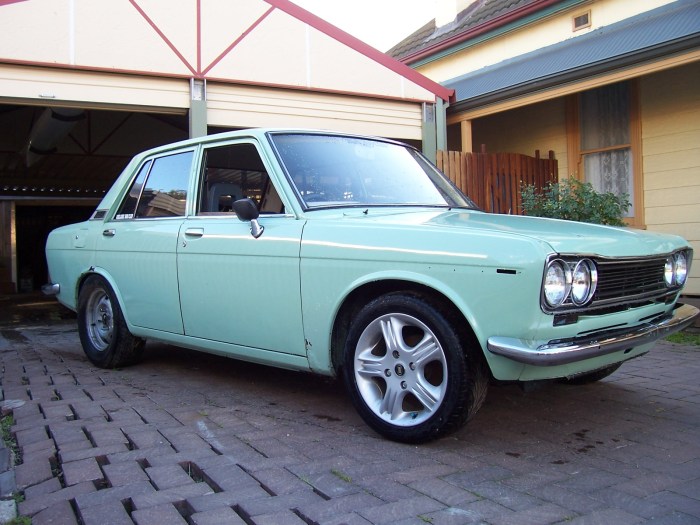
The Datsun 510, a compact car that made its debut in 1968 (released in 1969 in the United States), emerged during a period of significant change in the global automotive landscape. This era witnessed the rise of Japanese automakers, who were challenging the dominance of established American and European manufacturers.
The 510 was a pivotal model for Datsun, now known as Nissan, and its success played a crucial role in shaping the company’s global presence.The Datsun 510’s arrival coincided with growing consumer demand for fuel-efficient and reliable vehicles, driven by the energy crisis of the 1970s.
The car’s compact size, lightweight construction, and powerful yet economical engine made it an attractive option for budget-conscious drivers. Its performance on the racetrack, particularly in rallying, further enhanced its appeal and solidified its reputation as a sporty and capable vehicle.
Impact on the Global Automotive Landscape
The Datsun 510’s impact on the global automotive landscape was significant. It helped establish Datsun as a serious competitor in the international market, challenging the dominance of American and European brands. Its success paved the way for the rise of Japanese automakers as global players.
The 510’s influence extended beyond sales figures, as it set a new standard for compact car design, engineering, and performance.
Reasons for the Datsun 510’s Popularity
The Datsun 510’s popularity can be attributed to a combination of factors, including:
- Fuel Efficiency and Reliability:The 510’s compact size, lightweight construction, and efficient engine made it a fuel-saving option in an era of rising fuel prices. Its reputation for reliability further enhanced its appeal.
- Sporty Performance:The 510’s handling and performance on the racetrack, particularly in rallying, attracted a dedicated following of enthusiasts. Its nimble handling and responsive engine made it a joy to drive.
- Affordable Price:The Datsun 510 was priced competitively, making it an attractive option for budget-conscious buyers. Its affordability, combined with its performance and reliability, contributed to its widespread appeal.
- Innovative Design:The 510’s design, featuring a sleek and modern aesthetic, was ahead of its time. Its distinctive styling, combined with its practical features, made it a standout in the compact car segment.
Design and Features
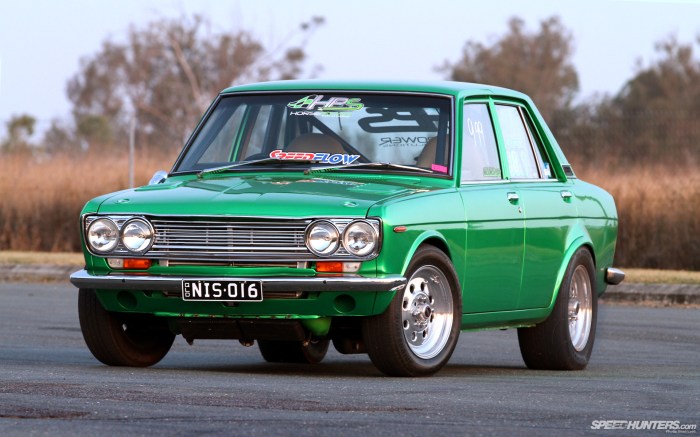
The Datsun 510’s design was a departure from the boxy, utilitarian styling of previous Datsun models. It embraced a more modern and sophisticated aesthetic, aimed at attracting a wider range of buyers, including those seeking a stylish and practical compact car.
This design philosophy played a significant role in the car’s success.The 510’s design incorporated a number of features that were ahead of its time, particularly in the compact car segment. It was known for its sleek and aerodynamic profile, achieved through a combination of flowing lines and a raked windshield.
This design not only enhanced its visual appeal but also contributed to improved fuel efficiency and handling.
Exterior Design
The exterior design of the 1969 Datsun 510 featured a number of distinctive elements. These included:
- A low-slung, sporty profile, achieved through a combination of a long hood, a short rear deck, and a raked windshield.
- A distinctive grille with horizontal chrome bars and a Datsun emblem.
- A wraparound windshield that provided excellent visibility.
- Large, rectangular headlights that were integrated into the front fenders.
- Flush-mounted door handles and a subtle rear spoiler that contributed to the car’s aerodynamic efficiency.
Interior Design
The interior of the 1969 Datsun 510 was designed with a focus on practicality and comfort. Key features included:
- A spacious and well-appointed cabin with comfortable seating for five passengers.
- A simple and functional dashboard layout with clear instrumentation.
- A high-quality interior trim that was durable and easy to clean.
- A large trunk that provided ample cargo space.
Unique Features
The Datsun 510 was equipped with a number of unique features that set it apart from its contemporaries, including:
- A MacPherson strut front suspension that provided excellent handling and ride quality.
- A rear independent suspension that further enhanced the car’s handling characteristics.
- A powerful and fuel-efficient four-cylinder engine that provided spirited performance.
- A four-speed manual transmission that offered precise and responsive shifting.
- A standard safety package that included a padded dashboard and seatbelts.
Engine and Performance
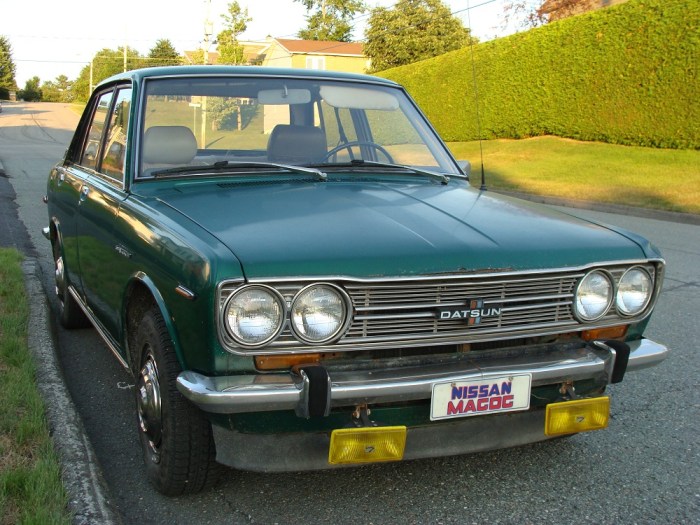
The 1969 Datsun 510’s engine was a testament to Japanese engineering, offering a balance of power and fuel efficiency that made it a standout in its class. This engine played a crucial role in the 510’s success, establishing its reputation for both performance and reliability.
The 1969 Datsun 510 was a game-changer, introducing a new level of performance and handling to the compact car segment. It was a true driver’s car, earning a reputation for its nimble handling and sporty nature. While the 510 was all about precision and agility, Datsun also released the iconic 1973 Datsun 240Z , which brought a whole new dimension of luxury and power to the market.
Both cars, in their own way, helped establish Datsun as a force to be reckoned with in the automotive world, and both continue to be celebrated for their timeless appeal.
Engine Specifications and Performance
The 1969 Datsun 510 was powered by a 1.6-liter four-cylinder engine, known as the “A12.” This engine, with its overhead camshaft design, produced 96 horsepower at 6,000 RPM and 93 lb-ft of torque at 4,000 RPM. The engine was paired with a four-speed manual transmission, offering drivers a direct connection to the powertrain.The 510’s engine was praised for its responsiveness and smooth acceleration.
While not a powerhouse in terms of raw horsepower, its lightweight design and efficient power delivery allowed it to achieve respectable performance. The 510 could sprint from 0 to 60 mph in around 12 seconds, a respectable figure for its time.
Comparison with Contemporary Engines
Compared to other engines in its class, the Datsun 510’s A12 engine stood out for its fuel efficiency. While other small sedans from American and European manufacturers offered more horsepower, they often came at the cost of higher fuel consumption.
The 510’s engine, with its efficient design, delivered better fuel economy without sacrificing performance.
The Datsun 510’s fuel efficiency was a major selling point, particularly during the era of rising fuel prices.
Driving Experience
The 1969 Datsun 510’s driving experience was characterized by its nimble handling and engaging driving dynamics. The car’s responsive engine and precise steering allowed drivers to navigate corners with confidence. The 510’s suspension, while basic, provided a comfortable ride without sacrificing handling prowess.The 510’s lightweight design contributed to its agility and responsiveness.
Its relatively small size and low center of gravity made it feel planted and sure-footed on the road. The car’s handling characteristics, combined with its reliable engine, made it a popular choice for both daily driving and occasional spirited driving.
Many drivers described the Datsun 510’s driving experience as “fun” and “engaging,” highlighting its balance of performance and practicality.
Cultural Impact and Legacy
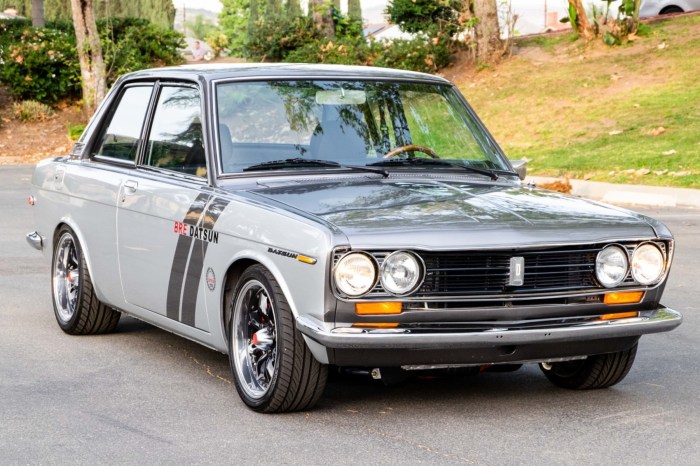
The Datsun 510, with its blend of affordability, performance, and practicality, transcended its status as a mere automobile, becoming a cultural icon that left an enduring mark on society. It resonated with a diverse audience, appearing in various forms of media and influencing the world of motorsport, solidifying its place in automotive history.
The Datsun 510 in Popular Culture and Media
The Datsun 510’s presence extended beyond the realm of everyday transportation, finding its way into popular culture and media. It appeared in numerous films and television shows, often portraying a sense of affordability, reliability, and even rebelliousness.
- In the 1974 film “The Sting,” the Datsun 510 served as the getaway car for the two con artists played by Robert Redford and Paul Newman. This film showcased the car’s nimble handling and sporty character, further solidifying its image as a capable and stylish vehicle.
- The Datsun 510 also made a notable appearance in the 1980s television series “Knight Rider,” where David Hasselhoff’s character, Michael Knight, drove a modified Datsun 510 as a backup car. This appearance helped to cement the Datsun 510’s reputation as a reliable and adaptable vehicle.
The 1969 Datsun 510 was a game-changer, known for its nimble handling and reliable performance. Its success paved the way for other Datsun models, including the 1971 Datsun 1600 , which offered a slightly larger engine and more luxurious features.
But the 510 remains a legend, a testament to Datsun’s early dominance in the compact car market.
The Datsun 510’s Impact on Motorsport
The Datsun 510’s impact on motorsport was significant, particularly in the United States. Its lightweight construction, responsive engine, and affordable price made it an ideal platform for competitive racing.
- The Datsun 510’s racing success began in the early 1970s, with drivers like John Morton and Peter Gregg achieving numerous victories in the Sports Car Club of America (SCCA) Trans-Am Series. This success helped to establish the Datsun 510 as a formidable competitor in the world of motorsport.
- The Datsun 510’s racing heritage continues to be celebrated today, with enthusiasts restoring and racing these iconic vehicles in various vintage motorsport events. This enduring popularity is a testament to the car’s enduring performance and legacy.
The Datsun 510’s Enduring Appeal
The Datsun 510’s legacy continues to inspire car enthusiasts today. Its blend of practicality, performance, and affordability remains highly sought after, making it a popular choice for restoration and modification.
- The Datsun 510’s simple design and robust construction make it a relatively easy car to maintain and restore, appealing to both novice and experienced mechanics. This accessibility has contributed to its continued popularity among car enthusiasts.
- The Datsun 510’s affordability and availability of parts make it a relatively inexpensive car to own and modify. This accessibility has allowed a wide range of enthusiasts to enjoy the car’s performance and styling, further contributing to its enduring appeal.
The 1969 Datsun 510, a true icon of the era, set the stage for a legacy of sporty and reliable Japanese cars. Its success paved the way for later models like the 1979 Datsun B210 , which offered a more affordable and fuel-efficient alternative.
While the B210 may not have been as iconic as its predecessor, it still captured the spirit of Datsun’s commitment to performance and value, solidifying the brand’s reputation for delivering dependable vehicles.
Technical Specifications
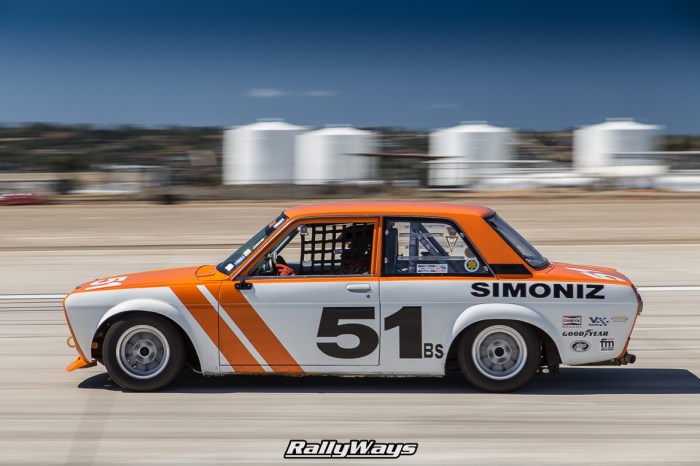
The 1969 Datsun 510’s technical specifications highlight its impressive engineering and performance capabilities. They demonstrate how Datsun, despite being a relatively new player in the international automotive market, managed to create a car that was both practical and sporty.
Technical Specifications Table
The table below summarizes the key technical specifications of the 1969 Datsun 510:
| Specification | Value |
|---|---|
| Engine | 1.6 L (96 cu in) I4, 85 hp (63 kW) |
| Transmission | 4-speed manual, 3-speed automatic (optional) |
| Dimensions | Length: 165.5 in (4,198 mm), Width: 62.6 in (1,590 mm), Height: 51.8 in (1,316 mm), Wheelbase: 94.5 in (2,400 mm) |
| Weight | 1,980 lb (900 kg) |
| Suspension | Front: Independent, coil springs, MacPherson struts, Rear: Live axle, leaf springs |
| Brakes | Front: Disc, Rear: Drum |
| Fuel Economy | Estimated 25 mpg (9.4 L/100 km) |
| Top Speed | 95 mph (153 km/h) |
Engine
The 1969 Datsun 510 was powered by a 1.6-liter (96 cubic inch) inline-four engine, producing 85 horsepower (63 kW) at 5,600 rpm. This engine was known for its reliability and fuel efficiency. The engine featured a cast-iron block and an aluminum cylinder head.
It also had a single overhead camshaft (SOHC) design, which was considered advanced for its time.
Transmission
The 1969 Datsun 510 came standard with a four-speed manual transmission. A three-speed automatic transmission was available as an option. The manual transmission was known for its smooth shifting and precise gear changes. The automatic transmission was also considered to be reliable and efficient.
Dimensions
The 1969 Datsun 510 was a compact car, with dimensions that made it easy to maneuver in urban environments. The car was 165.5 inches long, 62.6 inches wide, and 51.8 inches tall. It had a wheelbase of 94.5 inches. These dimensions made it a relatively spacious car for its class, providing ample room for passengers and cargo.
Weight
The 1969 Datsun 510 weighed approximately 1,980 pounds (900 kilograms). This relatively light weight contributed to its impressive handling and fuel efficiency.
Suspension
The 1969 Datsun 510 featured an independent front suspension with coil springs and MacPherson struts. The rear suspension was a live axle with leaf springs. This suspension system provided a good balance between ride comfort and handling.
Brakes, 1969 Datsun 510
The 1969 Datsun 510 was equipped with disc brakes on the front wheels and drum brakes on the rear wheels. This braking system provided adequate stopping power for the car’s size and performance.
Fuel Economy
The 1969 Datsun 510 was known for its fuel efficiency. It was estimated to achieve around 25 miles per gallon (9.4 liters per 100 kilometers). This was a significant advantage over many of its competitors at the time.
Top Speed
The 1969 Datsun 510 had a top speed of 95 miles per hour (153 kilometers per hour). This was a respectable speed for a car of its size and engine displacement.
Conclusion: 1969 Datsun 510

The 1969 Datsun 510 is a timeless classic. Its sleek design, impressive performance, and cultural impact have solidified its place in automotive history. From its early days as a budget-friendly alternative to its later successes in motorsport, the 510 has captured the hearts of car enthusiasts around the world.
Even today, the 510 continues to inspire, proving that a car’s legacy can extend far beyond its production years.